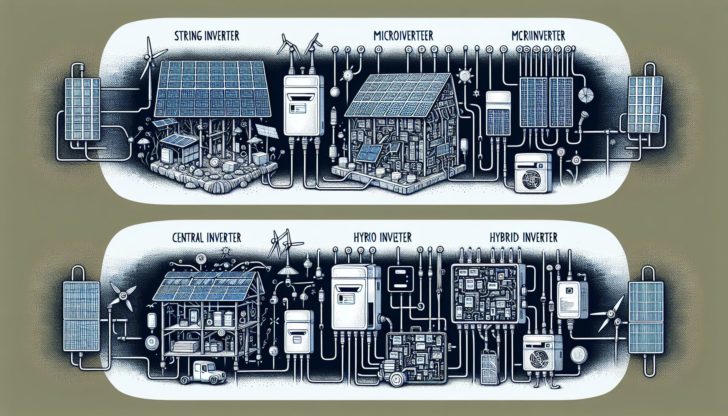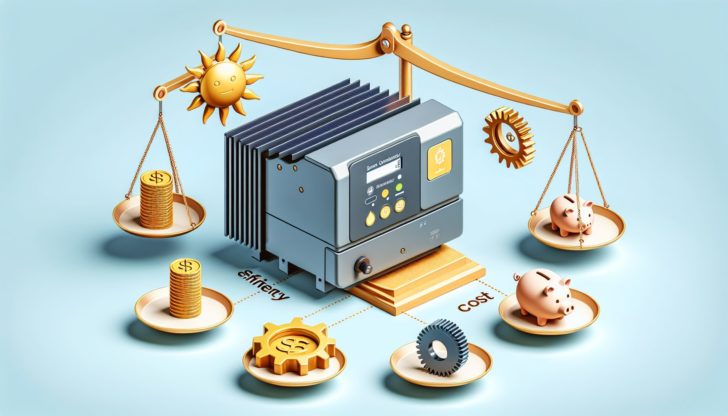Choosing the right solar inverter is key to harnessing your solar panels’ full potential. Responsible for converting the DC power your panels produce into AC power for home use, the inverter’s efficiency impacts your energy savings. This guide will walk you through types of solar inverters, how to pick one based on your home’s needs, and tips for installation and upkeep, providing all you need to make an educated choice without the sales pitch.
Table of Contents
Key Takeaways
Solar inverters are critical components in a solar panel system, converting DC to AC electricity for home and grid use, and enhancing the system’s efficiency and smart capabilities such as grid stabilization, rapid shutdown compliance, and system monitoring.
There are several types of solar inverters available, each suited for different needs: string inverters are cost-effective for systems with minimal shading, microinverters mitigate the impact of individual panel shading and allow easy expansion, and hybrid inverters combine grid-tied and battery functionalities for robust systems.
When choosing a solar inverter, homeowners should consider system size and compatibility, efficiency and performance, cost and budget, and the warranty and reliability of the product. Installation and maintenance by a qualified professional are essential for the inverter’s optimal performance and longevity.
Understanding Solar Inverters

Solar inverters serve as the pivotal component of any solar energy system. They work tirelessly behind the scenes, converting the DC electricity generated by your solar panels into AC electricity for your home. This process involves rapid switching of the DC input, resulting in an alternating current output suitable for home and grid use.
Yet, their duties go further than just facilitating power conversion. The efficiency of this transformation process is paramount in maximizing the energy production of your solar energy system. The more efficient your solar inverter, the more power you extract from your solar panels, leading to increased energy savings over time.
How Solar Inverters Work
But how does a solar inverter achieve this power conversion? The answer lies in its advanced internal components. Modern inverters leverage transistors, solid-state devices made of semiconductor materials, to control the flow of electricity and facilitate the conversion from DC to AC.
To certify the compatibility of the converted power with your home and the grid, the inverter uses filters and other electronic components. These components work together to generate an AC voltage that replicates a clean sine wave, the required pattern for grid compatibility. Maintaining a consistent sine wave of voltage over time is critical to inverter efficiency and, ultimately, the performance of your solar panel system.
Key Functions of Solar Inverters
Beyond power conversion, solar inverters perform several other essential functions. In fact, they are equipped with smart capabilities that significantly enhance the stability and efficiency of your solar energy system.
For instance, smart inverters can provide the following benefits:
Responding to changes in grid frequency and disruptions, helping to stabilize and manage the power grid
Complying with rapid shutdown codes by ensuring each solar panel can be quickly disconnected in case of an emergency
Offering advanced monitoring and control capabilities for the entire solar system, aiding in easier diagnosis and repairs
These features make smart inverters a valuable addition to any solar system.
It’s worth noting that the inverter’s efficiency depends on its load, typically showing high efficiency at higher output power and lower efficiency below 10-15% of power output.
Types of Solar Inverters

Having grasped the function and working mechanism of solar inverters, let’s delve into the various types suitable for home installations. There are three main types: string inverters, microinverters, and string inverters with DC power optimizers.
String inverters convert DC input from multiple solar panels into AC power for your home or grid. They are best suited for solar systems where panels face the same direction and have minimal shading.
On the other hand, microinverters, which typically have a power rating range between 190 to 220 W, offer distinct benefits for installations with complex shading issues or systems requiring future expansion and maximum power efficiency.
A third type, string inverters with optimizers, feature an improved setup where each solar panel is equipped with an optimizer. This device enhances DC power collection before it is converted to AC by the central inverter.
Selecting the appropriate size of an inverter is paramount to avoid power losses resulting from clipping or inefficiency if the inverter supersizes the solar array.
String Inverters
String inverters are a popular choice for many homeowners, offering a simple and cost-effective solution. They connect multiple solar panels in a series, hence the name ‘string’, and convert the collective DC input from these panels into AC power for your electrical panel or grid.
However, they come with some limitations. One notable constraint is their inability to individually monitor panel performance. This means that if one panel underperforms, it can affect the performance of the entire string, potentially leading to losses. Also, heat generation and the inability to discern individual panel power can affect the system’s overall productivity.
Despite these limitations, string inverters can be enhanced with DC power optimizers in scenarios with partial shading or suboptimal panel angles, improving each panel’s performance individually.
Microinverters

Microinverters offer an alternative to string inverters, providing a more granular approach to power conversion. Unlike string inverters that handle the output of an entire string of panels, microinverters are matched with the energy output of individual solar panels. This means each panel operates independently, optimizing power output and mitigating the effects of one underperforming panel on the entire system.
While microinverters offer several benefits, including:
Single-panel power optimization
Independent operation
Improved installation safety
Reduced system design costs
They come with a high upfront cost. Additionally, maintenance can be challenging due to the need for roof access and potential disassembly of solar modules for repair or replacement.
Central Inverters
Central inverters are often utilized in large commercial or industrial solar energy systems. They offer an impressive capacity to handle high voltage and power levels, making them ideal for large-scale installations. As this blog post focuses mainly on home installations, we won’t delve deeper into central inverters, but it’s worth noting their presence in the realm of solar inverters.
Hybrid Inverters
Hybrid inverters, also known as grid tied solar inverters, offer the best of both worlds, combining the features of both grid-tied and battery-based inverters. They offer:
MPPT technology to optimize solar energy harvesting
Grid-tie capabilities to interact with the electrical grid
Advanced software features to control power loads, avoid peak time-of-use rates, store energy usage data, predict the monthly energy bill, and suggest energy-saving measures.
Despite their versatility, hybrid inverters do have some drawbacks, including:
High costs
Lower efficiency ratings
Poorer warranties
Potential issues with software, as reflected in user reviews
However, their ability to maintain power supply independently from the grid during outages can make them a viable option for homeowners wanting a robust solar energy system with a reliable electrical system.
Factors to Consider When Choosing a Solar Inverter

After examining the diverse types of solar inverters, it’s vital to weigh different factors when selecting the ideal one for your home. Your inverter choice can greatly influence the efficiency and prolonged performance of your solar energy system.
The first step is to evaluate your solar energy system’s specific conditions, including your home’s orientation, shading, and local climate. These factors will influence the type of inverter that will work best for your system.
Furthermore, there are several key factors to consider when comparing different solar inverters, including:
System size and compatibility
Efficiency and performance
Cost and budget
Warranty and reliability
Let’s explore these factors in more detail in the following subsections.
System Size and Compatibility
One of the first considerations when choosing a solar inverter is the size of your solar panel system. The size of a solar inverter should correspond with the solar panel system’s maximum energy production to prevent efficiency and power loss issues.
However, when considering the size of the solar array and the inverter capacity, there are a few factors to keep in mind:
Environmental variables such as shading or suboptimal tilt may require a smaller inverter capacity relative to the solar array size.
Manufacturers may invalidate warranties if the solar array’s size doesn’t align with the inverter’s recommended guidelines.
If you’re planning on incorporating battery backup, selecting an inverter compatible with your planned energy storage system is crucial.
Learn more, visit Solar inverter sizing: Choose the right size inverter.
Efficiency and Performance
Efficiency is another crucial factor to consider when choosing a solar inverter. Inverter efficiency measures how efficient the inverter is at converting DC electricity into AC electricity, crucial to minimize electricity loss over time.
Solar inverters are ranked based on different efficiency ratings like peak (maximum) efficiency, European efficiency, and California Energy Commission (CEC) efficiency. These ratings reflect their performance at various output levels. High-quality sine wave inverters generally provide 90-95% efficiency, while modified sine wave inverters have lower efficiencies ranging from 75-85%. High-frequency inverters tend to have better efficiency than low-frequency alternatives.
Remember, the overall energy production and potential savings of a solar system are significantly influenced by the inverter’s efficiency ratings.
Cost and Budget
For homeowners investing in solar energy systems, cost remains a significant consideration. Solar inverter costs vary significantly based on their type and features. For instance, central inverters cost approximately $0.13 per watt, whereas microinverters cost about $0.34 per watt, demonstrating a notable price difference.
On average, residential solar inverters typically range in price from $1,000 to $2,000. While it’s tempting to opt for the cheapest option, remember that investing in a high-quality inverter can lead to better performance and savings in the long run.
Warranty and Reliability
Given that a solar inverter is a long-term investment, it’s imperative to take into account the warranty and the device’s reliability. Always examine the fine print of a solar inverter’s warranty, as it details coverage, exclusions, and the claims process.
Microinverter warranties, for example, typically span 25 years, much longer than those for string inverters. However, it’s also important to consider the brand’s customer service reputation. For instance, despite solid efficiency ratings and lengthy warranties, some brands like Tesla Solar Inverters have been noted for their customer service shortcomings.
Conversely, brands like Delta offer better warranties, efficiency ratings, and user app scores, alongside a better customer support reputation.
Popular Solar Inverter Brands
The market is flooded with an array of solar inverter brands, making the selection of the right one quite a challenge. Major players include Enphase, SMA, and other brands recognized for their reliability and reputation.
SolarEdge’s Home Wave Inverter is often considered the best overall solar inverter, offering the highest efficiency rating, various sizes, and a solid warranty. On the other hand, Growatt is noted for offering the best hybrid inverter with fair sizes, warranty, and pricing.
Enphase’s IQ8 Series stands out as the best residential microinverters, leading in the market due to their performance. While brands like Tesla offer solid efficiency ratings and lengthy warranties, they have been noted for their customer service shortcomings.
Key Features and Advantages
In the process of choosing a brand, one must consider the chief features and benefits of their solar inverters. For instance, SolarEdge’s Home Wave Inverter has the highest efficiency rating, available in various sizes, and comes with a solid warranty.
The Home Wave Inverter by SolarEdge is well-received by users, reflecting high satisfaction through very high app review scores. It’s also important to note the warranty period offered by different brands. Warranties ranging from 5 to 12 years are critical for protecting the efficiency and operation of solar inverters.
Customer Reviews and Testimonials
Customer reviews and testimonials serve as a rich source of information that can aid your decision-making process. High user review scores can offer a persuasive indicator of quality and reliability to potential customers looking to purchase solar inverters.
For instance, SolarEdge’s Home Wave Inverter and Enphase IQ8 Microinverters have achieved high satisfaction scores from users, reflecting positive experiences. Always take the time to read through reviews and testimonials as they can provide valuable insights into product performance and customer satisfaction.
Installation and Maintenance Tips
After deciding on your solar inverter, the subsequent stages involve its installation and maintenance. Due to the heavy weight of string inverters, often ranging from 25 to 65 pounds or more, it’s essential to have assistance during their installation.
Installation requires careful planning, especially around the sides that have DC and AC power connections to ensure safety and accessibility. All circuits should be off when making connections inside the inverter, with DC connections established before the solar panels are wired up. As this is a complex task, professional assistance from a skilled electrician is advised, particularly for installers who are inexperienced with electrical wiring.
Choosing the Right Installer
Opting for a reputable installer is essential to ensure a seamless and successful installation process. It’s advisable to choose an installer with qualifications, experience, and a strong track-record.
Remember, the installation of your inverter directly affects the performance of your solar energy system. A poor installation can lead to inefficiencies and potentially damage your system. Therefore, take the time to research and select a reputable installer who can ensure your solar inverter is installed correctly and safely.
Caring for Your Solar Inverter
Following the installation of your solar inverter, regular upkeep and maintenance are indispensable to guarantee optimal performance over its expected lifespan. String inverters, for instance, use shade, cooling fans, or a combination of both to dissipate heat and maintain efficient operation.
Maintaining the optimal operating temperature is vital for the efficiency and longevity of a solar inverter. Regular cleaning and keeping the area around the inverter clear of obstructions are important maintenance practices. Remember, a well-maintained solar inverter will serve you efficiently for years to come.
Summary
In conclusion, solar inverters play an essential role in harnessing solar power, transforming solar-generated DC electricity into usable AC power for your home. Understanding the different types of solar inverters, their operation, and their benefits and limitations can help you choose the right inverter for your solar energy system.
When choosing a solar inverter, it’s crucial to consider factors like system size and compatibility, efficiency and performance, cost and budget, and warranty and reliability. Remember, a well-chosen, properly installed, and adequately maintained solar inverter can drastically improve the performance of your solar energy system, leading to significant energy savings over time.
Frequently Asked Questions
What is the role of a solar inverter?
The primary role of a solar inverter is to convert the DC electricity produced by solar panels into AC electricity for household use or grid feeding.
What are the main types of solar inverters?
The main types of solar inverters for home installations are string inverters, microinverters, and string inverters with DC power optimizers. Each type has specific advantages and considerations to keep in mind.
How does a microinverter differ from a string inverter?
A microinverter optimizes power output and mitigates the impact of an underperforming panel on the entire system, while a string inverter converts the collective DC input from a series of panels into AC power. Both serve the same purpose of converting solar energy, but they differ in how they handle individual panel performance.
What factors should I consider when choosing a solar inverter?
When choosing a solar inverter, consider the size of your solar panel system, inverter efficiency and performance, cost, and the reliability and warranty of the inverter for the best decision.
How can I maintain my solar inverter?
To maintain your solar inverter, it’s crucial to regularly clean it, ensure it operates at the right temperature, and keep the surrounding area clear of obstructions. These practices are essential for its proper functioning.









